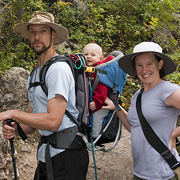Summiting Pikes Peak: September 8, 2007
More photos from the day are up in the gallery.
On my parents last day of their road trip, they ended up in Colorado Springs. Mark and I weren’t able to meet them for camping on Friday night because of Liv’s injury, but I drove down to the Springs on Saturday morning to meet up with them for the day. We had reservations on the 10:40 cog train to the summit of Pikes Peak!
Mom was a little nervous, as was I. Mark and I took this train two years ago, and I remembered it being VERY steep. But on Saturday, it wasn’t bad. The trip went quickly, the views were beautiful, and the whole family had a great time.
The summit wasn’t as cold as the last time Mark and I were up there, but the views were still great. TJ and I got Pikes Peak Summit doughnuts and macaroni and cheese! We hung out, shopped and took pictures for our allotted 45 minutes, and then it was back on the train down. The family had a great day, and lots of fun on this little adventure. We then hopped in the cars and headed home to the Fort!!






One Comment